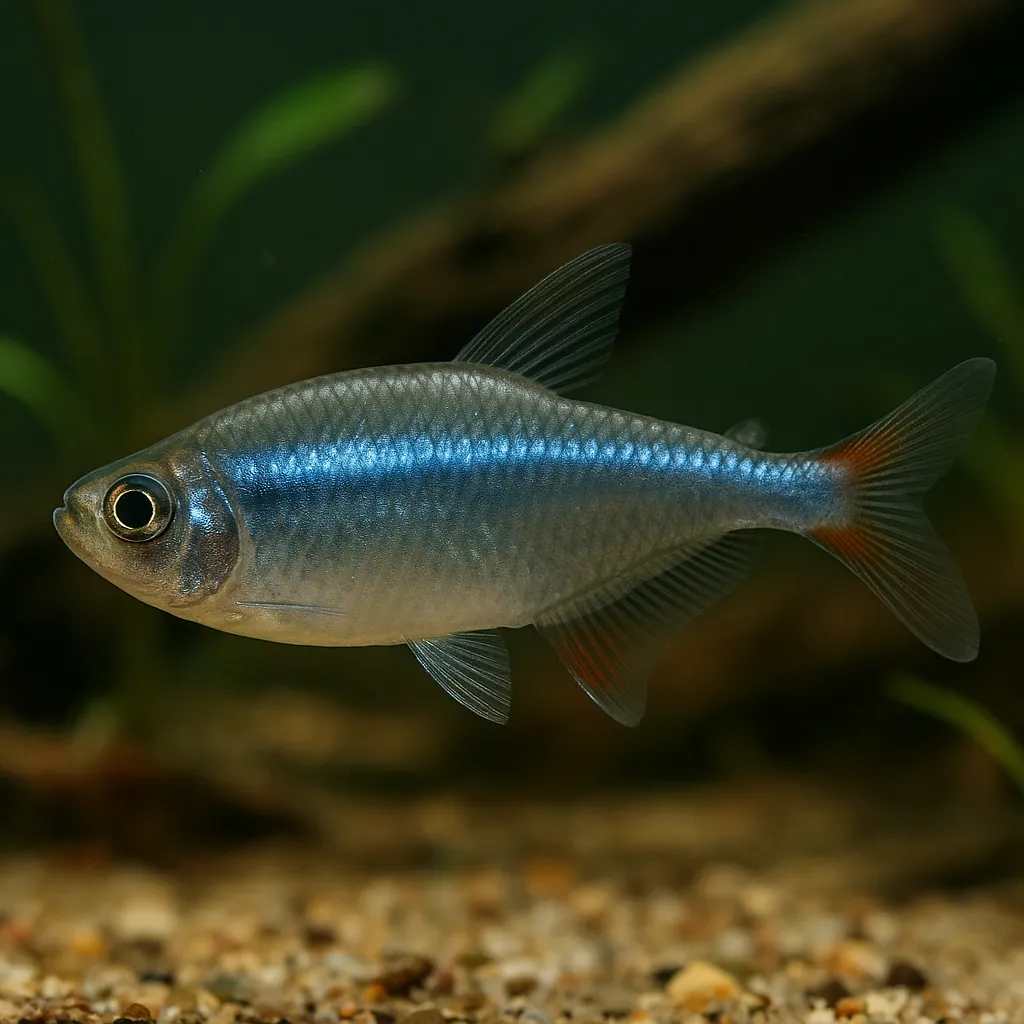
Blue tetra
Introduction
The Blue Tetra, scientifically known as Boehlkea fredcochui, is a captivating freshwater fish cherished by aquarists for its shimmering blue coloration and lively demeanor. This species is particularly appealing to hobbyists seeking an active and visually striking addition to their aquariums. While generally hardy, Blue Tetras do require specific care to thrive, making them suitable for aquarists with some experience in fishkeeping.
What makes the Blue Tetra a popular choice among aquarists?
Its vibrant blue hue and energetic swimming patterns add dynamic beauty to community tanks, enhancing the overall aesthetic appeal.
Is the Blue Tetra suitable for beginners?
While they are hardy, their specific care requirements and occasional fin-nipping behavior suggest they are better suited for aquarists with some prior experience.
Care and Environment
Proper care for Blue Tetras involves attention to tank size, water parameters, filtration, lighting, diet, and tank setup.
What is the minimum tank size for a single Blue Tetra?
A minimum of 20 liters is recommended for a single fish, but as they are schooling fish, it's best to keep them in groups.
What is the recommended tank size for a group of Blue Tetras?
A 75-liter tank is ideal for a group of six, providing ample space for swimming and reducing territorial behavior.
Maintain water temperatures between 22°C and 26°C, with a pH range of 6.0 to 7.0, and water hardness between 4 to 18 dGH. Regular water changes and efficient filtration are essential to keep the environment clean and stable.
Use gentle filtration systems, such as sponge filters, to avoid strong currents that can stress the fish. Moderate lighting, supplemented with floating plants, helps mimic their natural habitat and provides shaded areas.
As omnivores, Blue Tetras thrive on a varied diet. High-quality flakes or pellets should form the staple, supplemented with live or frozen foods like brine shrimp or bloodworms to enhance coloration and health.
Incorporate live plants, driftwood, and rocks to create hiding spots and replicate their natural environment. A darker substrate can accentuate their blue coloration. Ensure open swimming areas are available to accommodate their active nature.
Are Blue Tetras prone to any specific health issues?
They can be susceptible to common freshwater diseases like fin rot and ich, especially if water quality is poor. Regular monitoring and maintenance are crucial to prevent such issues.
Origin and Habitat
Blue Tetras are native to the fast-moving streams and rivers of Peru, thriving in freshwater environments with moderate currents. They are primarily found in shaded, densely vegetated waters, which provide cover and mimic the conditions they appreciate in aquariums. In the wild, their natural habitat allows them to school together for protection and engage in active swimming.
How does their natural habitat influence their care in captivity?
Replicating their natural environment with moderate currents, ample vegetation, and shaded areas helps reduce stress and promotes natural behaviors.
Temperament and Compatibility
Blue Tetras are generally peaceful but can exhibit fin-nipping behavior, especially during feeding times or if kept in insufficient numbers. They are schooling fish and should be kept in groups of at least six to minimize aggression and stress.
What are suitable tank mates for Blue Tetras?
Compatible companions include other tetra species, rasboras, small danios, peaceful barbs, and appropriately sized rainbowfish. Avoid housing them with fish that have long, flowing fins, as they may be prone to nipping.
How can I reduce fin-nipping behavior in Blue Tetras?
Maintaining a larger group and providing a spacious tank with plenty of hiding spots can help reduce territorial disputes and fin-nipping tendencies.
Interesting Facts
Blue Tetras are known for their metallic blue hue, which can reflect hues of pink and green, creating an iridescent effect that enhances their shimmering appearance. They are sexually dimorphic; males tend to be smaller with more vibrant coloration, especially during mating periods. In the wild, their schooling behavior serves as a defense mechanism against predators, a trait that continues in captivity, emphasizing the importance of keeping them in groups.
How long do Blue Tetras typically live?
With proper care, they can live up to 3 years in a well-maintained aquarium.
Sources
All information in this article has been gathered from the following reputable sources:
Overview
Recommended Tank Size 19.8 Gallons (for groups of 6 or more) |
Minimum Group Size 6 |
Minimum Tank Volume 5.3 Gallons |
Maximum Adult Length 2 inches |
Average Adult Length 1.6 inches |
Shoaling (6+ required) Yes |
Preferred Water Type Freshwater, soft, acidic |
Temperature Range (°C) 22–26 |
pH Range 6.0–7.0 |
Water Hardness (dGH) 4–18 |
Typical Lifespan (years) 3 years |